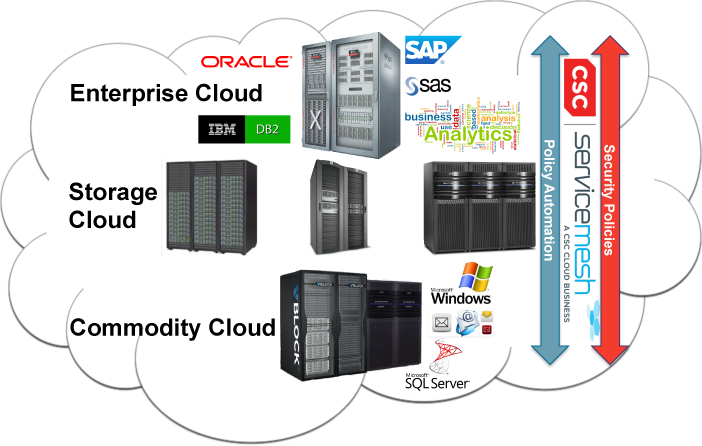<<< White Papers
Business Aligned Data Centres
Introduction
This is part one of the Business-Aligned Data-Centre series that looks at the challenges of delivering Information Technology with a business centric approach.
There are many definitions in use today, which are attempting to define the ideal template for running computerised systems that are aligned to the needs of the business.
Virtualisation has long been used to better utilise computing resources and grid computing is a good example of early attempts to provide a flexible and scalable architecture. Both of these technologies have continued to evolve and are now more commonly referred to as cloud computing. The latest development in this area is the introduction of the Software Defined Data-centre, which is attempting to define the complete automation of the delivery of services to the business.
The challenge has always been to align the data-centre’s capabilities with the businesses needs and requirements and part of the challenge being experienced today is in attempting to meet all of the businesses diverse needs and requirements from a single ubiquitous solution. Whereas the data-centre used to exclusively deal with large enterprise solutions, which could be easily standardised onto a common platform, todays ICT departments have to deal with everything from small commodity solutions that required very small processing and memory footprints all the way to the largest enterprise solutions that demand significantly more processing and memory requirements.
Forrester have recently published some articles around this phenomena:
In recent years, there has been a big push towards software-defined data centers, which aim to improve overall data center performance by optimizing the application layer and the hypervisor layer. However, Forrester argues that the business-defined data center cares about real services as opposed to less important applications.
The recent advent of Converged Infrastructures has facilitated a paradigm shift in data-centre solutions, these Vertically Integrated Infrastructures and Engineered Solutions greatly simplify the process of creating a Business Aligned Data-centre through the deployment of two or three or these standardised and vertically integrated architectures which in turn allow for a more business oriented approach.
Cloud Computing for the Enterprise
When we look at the typical workloads in a modern data-centre, there are three primary areas of utilisation.
- Commodity Usage; Typically low utilisation with one or two Central Processing Units (CPU) and less than ten or twenty Gigabytes (GB) of Random Access Memory (RAM).
- Storage Usage; Storage Area Networks (SAN) and Network Attached Storage (NAS) have been commonplace in the data-centre for a number of years and most companies have already standardised around their chosen solution within this layer.
- Enterprise Usage; Typically high or very high utilisation with tens or hundreds of CPUs in use and often using hundreds of Gigabytes (GB) or even Terabytes (TB) of RAM or more. These are often business critical systems with very high availability and performance requirements and are often excluded from organisational cloud strategies.
Recent advances in chipset and server design, and more specifically in Engineered Systems, enable the creation of an Enterprise Class Cloud environment that meet the most stringent performance, security and availability requirements.

Defining the Enterprise Cloud
Most businesses do not generally differentiate between the commodity cloud and the enterprise cloud, instead focusing on the business initiatives of reducing costs, improving service levels and obtaining faster results, be that improved time to market for new initiatives or facilitating real time decision making for example. For this reason the distinction between the enterprise and commodity cloud is not immediately obvious to most observers.
However, within most organisations the data-centre has evolved over a number of decades and contain a plethora of systems and technologies that are often competing and isolated. The only constant for most companies has been the Wintel estate which, by it’s very proprietary nature, has forced a common technical approach from all vendors and thus is the natural choice for any company’s initial venture into a private cloud initiative. The common nature of these environments often results in successful consolidation initiatives, via virtualisation technologies, onto a private cloud platform giving organisations confidence to address the larger enterprise space.
The mistake that some companies make at this stage is in attempting to use the commodity solution to consolidate the enterprise estate. Whereas a single supplier dominates the commodity space, no such domination exists in the enterprise space where several large vendors have equal presence and have optimised their solutions to take advantage of their own propriety, and non-standard, solutions. This approach typically requires large and costly programmes of work to migrate and transform the enterprise estate onto the commodity cloud and because of the cost and scale of these solutions the programmes are often abandoned part way through once it becomes apparent that the projected savings are not going to be realised in a realistic time scale.
A New Approach
The solution for the enterprise cloud is not dissimilar to the solution that most companies have deployed for the commodity cloud, the essential difference being that it is tailored towards the needs of large scale, mission critical systems.
The enterprise solution requires a single pool of resources that can scale both vertically and horizontally with;
- Fine grained controls
- That can ingest existing enterprise solutions without requiring costly transformations and upgrades,
- That provide physical, air-gapped isolation, logical isolation or co-existence as required
- That can integrate with existing storage solutions without requiring large new investments.
Oracle’s Engineered Solutions provide all of this and more; their new range of solutions provide standard building blocks that can be tailored to the needs of individual organisations without requiring costly configurations and customisations. And while recent developments have been optimised to run the latest Oracle solutions with maximum efficiency, they have also been engineered to run all enterprise class solutions irrespective of the vendor.
So for example these Engineered Solutions are equally capable of running a modern Oracle 12c cloud environment alongside an ageing Oracle 9i application or a DB2 version 10 application alongside a DB2 version 8 application all on the same Engineered System.
The Engineered Solution
Oracle’s engineered Solutions are architected to deliver three levels of separation to meet the requirements of most enterprise class solutions.
Physical Separation
At the highest level these systems support electrical separation of environments that meet the most stringent isolation requirements of enterprise systems. All of the resources in these environments are physical assigned to the environment thus delivering native hardware speed.
Logical Separation
Logical separation is optionally delivered from within the physical environment. Logically separated environments deliver all the benefits of the physically separated environment with the exception of the electrical isolation but crucially retain the physically assigned components allowing for the delivery of native hardware speed.
Virtual Separation
Virtual separation is optionally delivered from within the logically separated environment. In these environments the underlying resources are shared whilst retaining the separation of the environment, which gives the greatest level of granularity and flexibility for deploying systems.
Resource Flexibility
These environments deliver fantastic levels of flexibility, delivering massively diverse environments that meet nearly all enterprise requirements

In addition to this the Oracle Engineered Solution supports most types of shared storage including
- Fibre Channel attached Storage Array Networks
- 1GB & 10GB attached Network File Servers
- Infiniband attached Storage arrays
